Regional art galleries draw tourists from far and wide
On the trail of our top regional art collections across Australia.
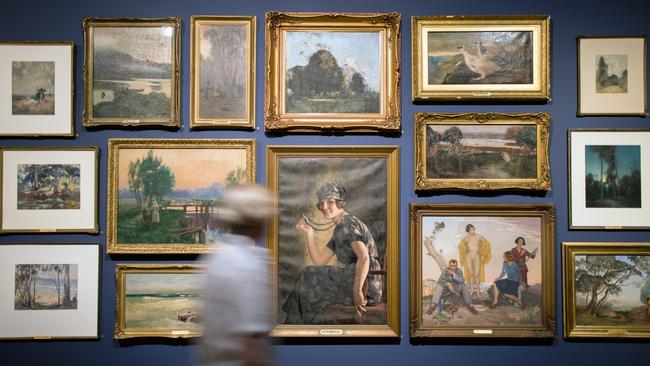
Australia’s regional art collections draw visitors from across Australia. Here’s a selection of some our best.
New England Regional Art Museum, Armidale, NSW
If it weren’t for the generosity of two men, this gallery at Armidale, halfway between Sydney and Brisbane, might not be so extraordinary. The institution owes much of its incredible collection to Howard Hinton and Chandler Coventry, two benefactors of different generations linked by their passion for art. British-born Hinton, a company director who spent time living in one of Sydney’s bohemian harbourside artists’ camps, was a prolific collector of Australian works dating from the 1880s to the 1940s. Arthur Streeton, Tom Roberts, Nora Heyson, Margaret Preston, Elioth Gruner and Norman Lindsay all feature in a treasure trove of more than 1300 paintings. Between 1929 and 1948, Hinton donated these to the Armidale Teachers’ College. Coventry, a Sydney gallery owner born into a local grazing family, focused on artists from the 1960s and ’70s, including Brett Whitely, Gunter Christmann and Janet Dawson. In the late ’70s, he offered his collection to the city of Armidale on the proviso a gallery be purpose-built to house both his and Hinton’s works. And so it came to pass; the gallery opened in 1983. Take time to browse the salon hang of 132 of Hinton’s favourite paintings and the smaller display of Coventry’s collection. With six gallery spaces, there’s room for exhibitions by a diverse range of local talent. During my visit, Del Kathryn Barton’s animated short film of Oscar Wilde’s The Nightingale and the Rose is showing. Downstairs, the fascinating Museum of Printing houses a collection of vintage printing presses from 1850.
STAY Tattersalls Hotel; tattersallsarmidale.com.au.
PENNY HUNTER
READ MORE: Cultural tourism on the road to recovery | Four fab art experiences
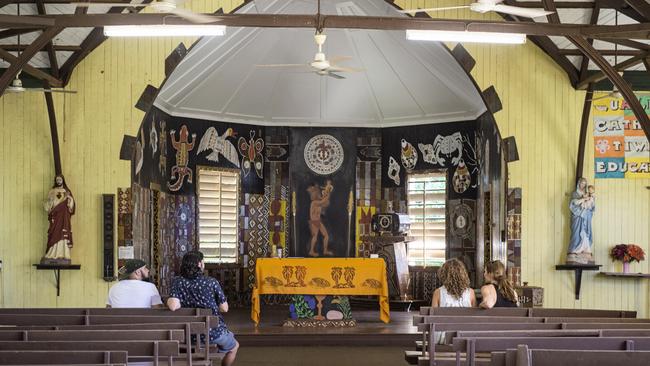
Tiwi art culture, Bathurst Island, NT
A glimpse into the culture of the Tiwi people is a joyous opportunity (including dancing and damper). The Tiwi Islands were cut off from the mainland by the last ice age 11,000 years ago and the separation resulted in customs quite distinct from other Top End Indigenous groups. There are no boomerangs, but lots of varieties of throwing sticks, as I discover at the excellent Patakijiyali Museum in Wurrumiyanga. Art is all around, including at the Women’s Centre, where fabric designs are printed and clothes are made to sell to the community and tourists. Tiwi Designs, one of Australia’s oldest Indigenous art centres, has been operating since the early 1960s and is home to the creation and sale of a diverse range of traditional carvings and silk-screen-printed fabrics. Both places are important community hubs, as is the Catholic church, built in the ’40s in Queenslander style, and with altar art unlike any on the planet. The recent movie Top End Wedding gives a glimpse, but nothing matches a visit to this island, which also has a wealth of postcolonial history.
STAY Coral Expeditions has 2021-22 itineraries between Darwin and Cairns that include the Tiwi Islands; coralexpeditions.com.
JANE NICHOLLS
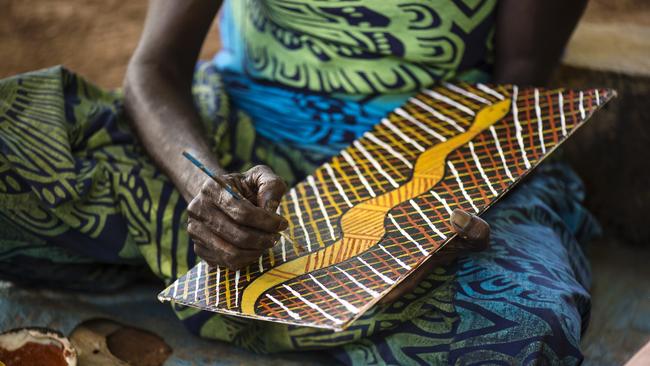
Bendigo Art Gallery, Victoria
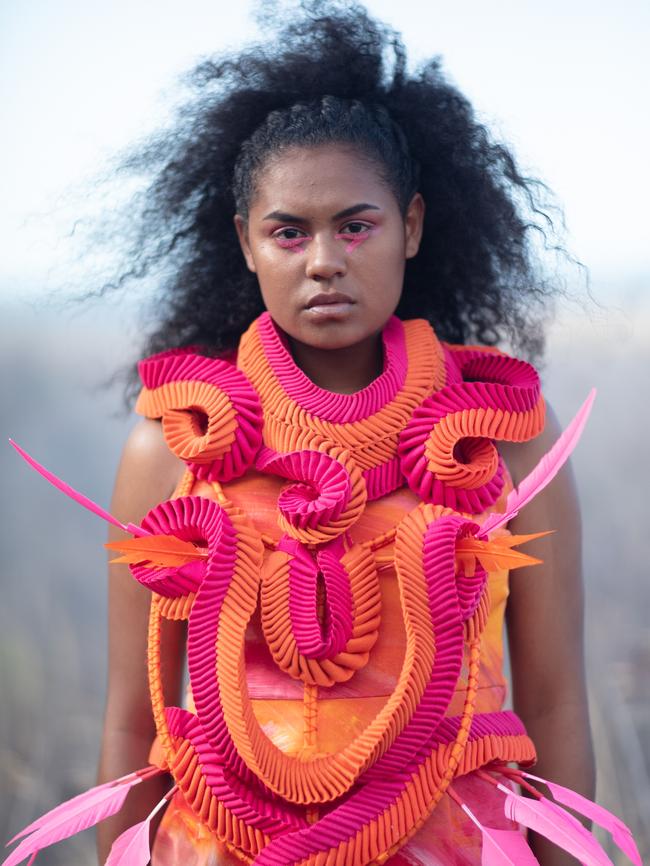
Many of the best textiles and design collections to come to Australia have been exclusive to this regional city, 90 minutes by road from Melbourne airport. As a few examples, BAG has presented 200 Years of Wedding Dresses, the contrasting styles of Grace Kelly and Marilyn Monroe, and even 350 Years in Underwear with everything from Dior and Westwood to Queen Victoria’s drawers. In 2018, it held a tribute showing of Finnish design icon Marimekko, while last year’s headline act was Balenciaga. BAG is ready to reignite its design theme from September 5 with Piinpi, the first major survey of contemporary Indigenous Australian garments and textiles. Put together by the gallery’s young First Nations curator Shonae Hobson, the colours and textures are like nothing else. Details are still under wraps, but a dazzling fashion import is slated for next March, focused on the 1960s and ’70s. BAG’s permanent collection underscores its heritage as a Gold Rush boom town, with important oils and sketches from the 1850 to the 1890s, followed by examples from Heidelberg School luminaries Frederick McCubbin, Tom Roberts and Walter Withers. Patricia Piccinini, Ben Quilty and Emily Kame Kngwarreye headline the contemporary offerings, with a rollcall of special showings, including photographer Bill Henson, death-row painter Myuran Sukumaran and the confronting sculptures of Ron Mueck.
STAY Bishopscourt, a converted 1870s mansion; bishopscourt.com.au.
JEREMY BOURKE
Mitchelton Gallery of Aboriginal Art, Nagambie, Victoria
Whether you arrive by lift or, more grandly, via the brick-arched, Robin Boyd-designed cellars, the first sight of this underground gallery, a little over an hour from Melbourne, is a joyous shock of pattern and vividness. Dozens of artworks colour the all-white space but it is the large-scale canvases — almost 5m long and half as tall, painted by some of our best-known Indigenous artists — that leap out. The masterpiece is an arresting work by the late, great Pitjantjatjara artist Yannima Tommy Watson. Called Warnka Tjukurpa, depicting his birth country at Anumarapiti, Western Australia, its asking price is $1 million. Most works are for sale but cost significantly less, starting at a few thousand dollars. Art consultant Adam Knight and Mitchelton Winery’s owner Gerry Ryan established the gallery in 2018, drawing on Knight’s contacts with Aboriginal artists. More than 20 Indigenous art centres are represented, and there is also a museum shop with more affordable treasures including Sherrin footballs handpainted at Santa Teresa Mission near Alice Springs, sculptures by Tjanpi Desert Weavers and the popular Desert Dogs, metal cut-outs of actual Tanami Desert hounds decorated by women artists in Yuendumu. Definitely not for sale is The Message Stick Vehicle, a Vietnam War ambulance painted by hundreds of Indigenous artists during a decade-long, post-war odyssey around the continent. Filmmaker Michael Butler asked artists in each community to leave messages for each other, transforming a war vehicle into a peace envoy. Open weekends, with 11am guided tours.
STAY Mitchelton Winery Hotel; mitchelton.com.au/hotel.
KENDALL HILL
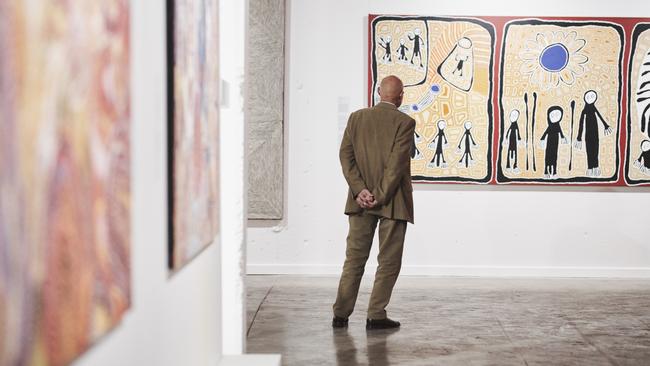
Tjulyuru Regional Arts Gallery, Warburton, WA
The Outback Way, dubbed Australia’s “longest shortcut” because it’s the shortest way to get, by road, from Perth to Cairns or vice versa, is also Australia’s longest art trail. Spearing through the heart of Central Australia and the western deserts, almost every small community between Kalgoorlie and Alice Springs has an Indigenous art gallery or co-operative art centre. Some sell direct to the travelling public, others to commercial galleries in the cities, but Tjulyuru Regional Arts Gallery in the tiny community of Warburton on the edge of the Gibson Desert — home to a roadhouse with a few motel units, a caravan park and not much else — was set up in 1989 by the Ngaanyatjarra people to collect and retain the best works of local artists as a way to help keep their culture strong. Fast forward three decades and there’s now more than 1000 contemporary works in the impressive museum and gallery space, the largest collection of Indigenous art under the direct ownership of Aboriginal people in the country. It’s also one of the most remote; the nearest big town, Kalgoorlie, is 900km to the southwest, Alice Springs is 1000km away in the other direction, and both are at least a two-day drive across the mostly unsealed Great Central Road. There are about 900 paintings in the collection, but it’s the large textile pieces and contemporary art glass, produced in a kiln onsite, that really steal the show, including glass bowls and panels featuring traditional designs originally drawn in sand before being transformed into glass.
STAY Warburton Roadhouse; warburtonroadhouse.com.au.
LEE ATKINSON
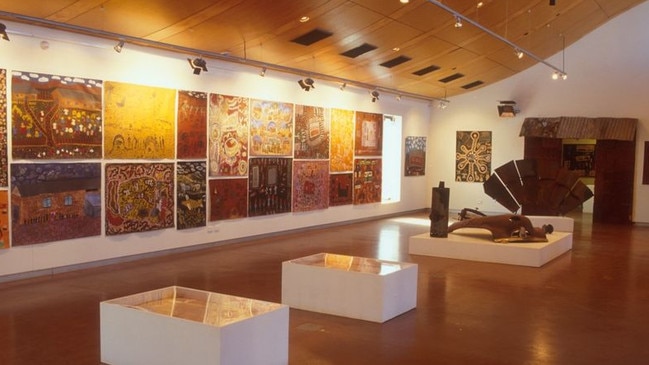
Margaret Olley Art Centre, Tweed Regional Gallery, Murwillumbah, NSW
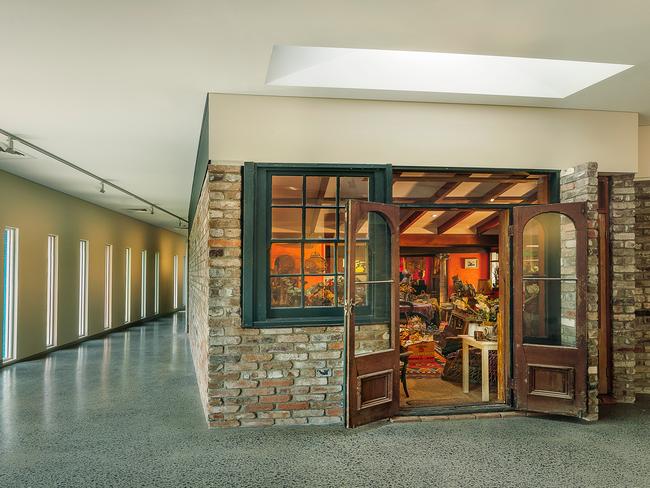
It is as though the artist, one of Australia’s finest of the 20th century, has just stepped out of her living room studio, maybe to make a cup of tea in the adjacent green kitchen. This is exactly as Margaret Olley’s creative spaces, the Hat Factory and Yellow Room, were when she died in July 2011, although now relocated 800km north of Paddington, Sydney, to northern NSW. The studio is a dazzle of items, 20,000 all up, that fired her imagination, including sculptures, statues, vibrantly coloured rugs and throws, vases and glassware, pencils, brushes and paints, and flowers everywhere, both dried and regularly replenished fresh. And, yes, ashtrays and cigarette butts. While Olley is perhaps best remembered for her luscious paintings of bowls of flowers in interior settings, she remained a country girl at heart, ever fond of her green childhood home in the Tweed River region, just south of the Gold Coast and 90 minutes from Brisbane. Hence the re-establishment of her studio in a purpose-built home with splendid pastoral views across to Mount Warning. The Margaret Olley Art Centre displays works by her and contemporaries, and supports a research library, education workshops and an artist-in-residence program. The Tweed Regional Gallery also has an impressive permanent collection, specialising in Australian portraits, regional works and artists’ prints.
STAY Halcyon House, Cabarita Beach; halcyonhouse.com.au.
GRAHAM ERBACHER

To join the conversation, please log in. Don't have an account? Register
Join the conversation, you are commenting as Logout